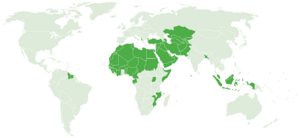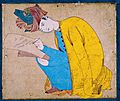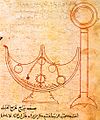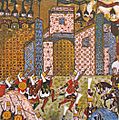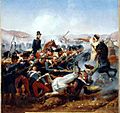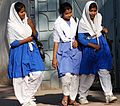Islamic world facts for kids
The Islamic World refers to all people who follow the religion of Islam. It is not just one place on a map. Instead, it is a global community of believers. When Muslims act together, they are called the "umma". This word means "community" and includes all Muslims worldwide.
The Islamic faith teaches unity and supporting fellow Muslims. Because of this, Muslim nations often work together. This cooperation can sometimes cause conflicts to spread. However, it can also help make conflicts shorter and less harmful. Sometimes, it might even prevent them from starting at all.
Contents
Where Muslims Live
Muslims live in many countries around the world. In 52 nations, Muslims make up the majority of the population. Most Muslims are Sunni. They speak about 60 different languages and come from all kinds of ethnic backgrounds.
Here are some places where many Muslims live:
- About 10.4 million Muslims live in Canada and the United States.
- Around 2.2 million Muslims are found in Latin and Central America.
- The European Union, along with Bosnia-Herzegovina and Albania, has about 10.0 million Muslims.
- There are few or no Muslims in Eastern Europe or Norway.
- Turkey is home to 62.4 million Muslims.
- The Arab League has 284.4 million Muslims, including Iraq where about 15 million are Shia (60% of Iraq's population).
- About 254.0 million Muslims live in Sub-Saharan Africa.
- Iran has 65.4 million Muslims, with 90% being Shia.
- In Central Asia, countries like Azerbaijan, Uzebekistan, Tajikistan, Kazakhstan, and Kyrgyzstan have 48.5 million Muslims. These countries were once part of the Soviet Union.
- Russia has 26.7 million Muslims.
- Afghanistan has 22.7 million Muslims.
- Pakistan and Bangladesh (which was once called East Bengal) have 230.0 million Muslims.
- The Republic of India has 133.3 million Muslims. This includes Jammu and Kashmir. India has the world's largest Muslim minority population.
- China is a close second with 133.1 million Muslims.
- Somalia has 34.6 million Muslims.
- Indonesia is home to 196.3 million Muslims.
- The rest of South-East Asia, especially Malaysia, has 30.0 million Muslims.
- There are few or no Muslims in Japan, Australia, New Zealand, Mongolia, or the South Pacific.
In total, there are about 1.5 billion Muslims worldwide.
News and Media in the Islamic World
The Al-Jazeera satellite TV network is a popular news source for many Muslims. It broadcasts in the Arabic language.
In most Muslim countries, the government is the main source of news. This can sometimes make it hard or even risky to share opinions that are against the government.
However, there are also many other news programs and websites available in the Muslim world.
Islam's Role in Law and Ethics
Islamic law is known as shariah in Arabic. It has many different forms. Five main schools of Islamic law were created centuries ago. These are called the classical fiqh.
- The Hanafi school is common in India, Pakistan, Bangladesh, West Africa, and Egypt.
- The Maliki school is found in North Africa and West Africa.
- The Shafi school is used in Malaysia and Indonesia.
- The Hanbali school is followed in Arabia.
- The Jaferi school is used in Iran and Iraq, where most people are Shia.
These five schools are very old. Many Muslims believe that new laws are needed for modern society. Islam has ways to create new laws, called al-urf and ijtihad. However, these methods have not been used for a long time. Few people are trusted enough to use them to make new laws today.
Because of this, many people in the Muslim world are very traditional. This is especially true regarding things like alcohol. Also, there are strong views about women working in certain jobs.
Muslim women often choose to dress very modestly. This means covering their bodies and sometimes their heads. In some countries, women are required to dress this way. This difference in customs can sometimes cause misunderstandings between the Western World and Muslim countries.
Islamic economics generally does not allow debt with interest. However, in most Muslim countries, Western-style banking is allowed. This is another topic that some Muslims discuss when thinking about the Western world.
Islam's Role in Politics
About one-quarter of the world's population follows Islam. For many people in Muslim countries, Islam is a political movement. This means they believe their faith should guide how their country is run.
In countries with democratic systems, there is often at least one Islamic party. These parties aim to bring Islamic values into government.
Political Islam is very influential in all countries where most people are Muslim. For example, Islamic parties have gained power in countries like Pakistan and Algeria.
Some groups in these movements call themselves Islamists. This term can also describe more militant Islamic groups. The way these groups relate to democracy can be complicated.
Some groups are called terrorists. This is because they attack ordinary people in other non-Muslim countries. They do this to make a political point or to achieve their goals.
Conflicts with Israel and the United States
Israel is often viewed negatively in the Muslim world. This is mainly because of the Israeli-Palestinian conflict. Many Arabs also felt that the way Israel was created in 1948 was unfair.
Some Muslims see this conflict as a fight against Judaism or Jews. However, not all Muslims share this view. For example, in Morocco, some Islamic groups have invited Jews to join their political party. Also, some Jewish groups, like Neturei Karta, work with Arabs in the West Bank. This small group of Jews also believes Israel was created unfairly. But it is important to know that most Jews support Israel as a state.
A big change happened in 1979 for the Muslim world. In that year:
- Egypt made peace with Israel.
- Iran became an Islamic state after a revolution.
- The Soviet Union invaded Afghanistan.
Many things changed because of these events. By 2001, the Soviet Union no longer existed. Jordan had also made peace with Israel. Then, on September 11, 2001, major attacks happened in the U.S. Many people believe these attacks aimed to make the United States leave the Muslim world, especially Saudi Arabia. In many ways, the events of 1979 led to the events of 2001.
The 2001 invasion of Afghanistan and 2003 invasion of Iraq were called part of a War on Terrorism by the United States. However, many Muslims saw these actions as a War on Islam. After the invasion of Iraq, Islamic parties gained more power. Polls in many Muslim nations showed support for Osama bin Laden. People said he would "do the right thing." A French scholar named Olivier Roy believes this support was not for al-Qaeda or militant Islam. Instead, he thinks it showed opposition to colonialism and what many Muslims call racism. This refers to what they see as special treatment for Jews, especially those living in West Bank settlements. Many of these settlers have American or British passports, and the United Nations says they do not have the right to live there.
This situation is very complex, and people have many different views on it.
How Muslim Nations Work Together
The Organization of Islamic Conference (OIC) was formed in 1969. It allows Muslim nations to work together as a group. Russia joined the OIC in 2003.
The Arab League is a smaller group that includes only Arab countries.
OPEC is another group where Muslim and non-Muslim countries discuss issues. In 1973, to protest U.S. support for Israel, there was an oil embargo. This caused the 1973 energy crisis.
Related pages
Images for kids
-
Ibn Rushd (Averroes), a Muslim scholar from Al Andalus.
-
The Spinning wheel was invented in the medieval era in the Middle East. It helped greatly in the Industrial Revolution.
-
Indonesia has the largest Muslim population in the world.
-
Map showing different Islamic schools of law across the Muslim world.
-
Muslim Rohingya refugees in Cox's Bazar, Bangladesh.
-
Sultan Mahmud of Ghazni receiving a special robe from the caliph al-Qadir in 1000.
-
A battle between Ismail of the Safaviyya and the ruler of Shirvan, Farrukh Yassar.
-
Shah Abbas I of the Safavid Empire meeting with Vali Muhammad Khan.
-
Mir Sayyid Ali, a scholar writing about the Quran during the reign of Mughal Emperor Shah Jahan.
-
A Persian miniature of Shah Abu'l Ma‘ali, a scholar.
-
Hadiqatus-suada by Oghuz Turkic poet Fuzûlî.
-
Cassim in the Cave by Maxfield Parrish.
-
Nasir al-Din al-Tusi's Astrolabe from the 13th century.
-
Abu al-Qasim al-Zahrawi's Kitab al-Tasrif showing surgical instruments.
-
A self-trimming lamp from Banū Mūsā's work On Mechanical Devices about Automation.
-
An illustration from al-Biruni's astronomy works, explaining moon phases.
-
"Cubic equations and intersections of conic sections" by Omar Khayyam.
-
A Safavid Empire Zamburak.
-
Bullocks pulling siege-guns during Mughal Emperor Akbar's Siege of Ranthambore Fort in 1568.
-
The Mughal Army under Aurangzeb recapturing Orchha in October 1635.
-
Ottoman Janissaries fighting the Knights of Saint John at the Siege of Rhodes in 1522.
-
Cannons and guns of the Aceh Sultanate (in modern Indonesia).
-
Mughal Emperor Shah Alam II meeting the East India Company after being defeated.
-
East India Company's Robert Clive meeting the Nawabs of Bengal before the Battle of Plassey.
-
Combat during the Russo-Persian Wars.
-
The French campaign in Egypt and Syria against the Mamluks and Ottomans.
-
The Java War between the Netherlands and Javanese led by Prince Diponegoro, from 1825 to 1830.
-
The Hispano-Moroccan War between Spain and Morocco.
-
The Italo-Turkish War between Italy and the Ottoman Empire from 1911 to 1912.
-
The Christian reconquest of Buda, Ottoman Hungary, 1686.
-
Anglo-Egyptian invasion of Sudan 1896–1899.
-
Turkish Muslims praying at the Eyüp Sultan Mosque on Eid al-Adha.
-
Friday prayer for Sunni Muslims in Dhaka, Bangladesh.
-
Druze leaders celebrating the Nabi Shu'ayb festival.
-
Ibadis living in the M'zab valley in Algerian Sahara.
-
Most people in the Hunza Valley in Pakistan are Ismaili Muslims.
-
Young school girls in Paktia Province of Afghanistan.
-
A primary classroom in Niger.
-
Schoolgirls in Gaza lining up for class, 2009.
-
Medical students of anatomy in Iran.
-
Taj Mahal in Agra, India, built during the Mughal Empire.
-
Sultan Ahmed Mosque in Istanbul, Turkey.
-
Sultan Salahuddin Abdul Aziz Mosque in Selangor, Malaysia.
-
Great Mosque of Córdoba in Spain, a Moorish-style mosque.
-
The design of Faisal Mosque in Islamabad, Pakistan is inspired by a Bedouin tent.
-
Islamic calligraphy used as an amulet for sailors in the Ottoman Empire.
-
Modern Islamic calligraphy showing different planets.
-
A Kazakh wedding ceremony in a mosque.
-
A group of marabouts – West African religious leaders and teachers of the Quran.
-
Muslim girls at Istiqlal Mosque in Jakarta.
-
A tribal delegation in Chad.
-
Minangkabau people (Padang, Western Sumatra) reciting the Al-Qur'an.
-
Muslim girls walking to school in Bangladesh.
See also
 In Spanish: Mundo islámico para niños
In Spanish: Mundo islámico para niños


